Exhibitions
Nature and Abstraction – Designs for Monumental Paintings from the 1970–1980s
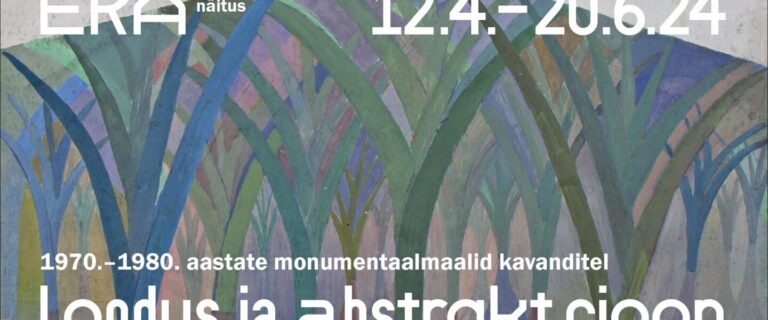
Monumental painting emerged as a significant medium in Estonian art during the
1960s. However, formal instruction in this area gained momentum at the art academy
over the subsequent two decades. During this period, the ideas of several painting
students progressed from concept to completion in various materials. Examples
include the stained glass works of Urve Dzidzaria and Heli Tuksam, which originated
from their diploma projects. The preliminary work of these projects is also displayed
at the current exhibition.
While Soviet official art typically featured propagandistic content in works intended for
public spaces, neither our professional monumental painting nor the students’ works
adhere to this approach. Guided by the enthusiastic mentorship of Dolores Hoffmann,
students developed universally human and aesthetic solutions in monumental
painting. One noticeable trend is the oscillation between nature-inspired, realistic
design creation and the abstract style, where recognisable figures have been lost.
This selection presents various personal approaches, ranging from a slightly stylised
manner to completely abstract expression. In each case, the artists have carefully
considered the future technique of execution, whether it be fresco, sgraffito, mosaic
or stained glass.
Several artworks that were removed from the old EKA building on Tartu Road before
its demolition have been subsequently reinstalled and showcased in the new
academy building. Furthermore, contemporary pieces have been introduced, as
instruction in monumental painting continues under the guidance of Heldur Lassi at
the Estonian Academy of Arts, albeit on a more modest scale today. Present-day
students are not constrained by traditional boundaries – they do employ classical
techniques but boldly blend them together as dictated by the content. This exhibition
provides viewers with the opportunity to establish conceptual links between different
approaches from various periods, prompting them to seek out the completed
monumental paintings, both old and new, within the public spaces of the EKA.
The artworks showcased in the exhibition were initially featured at the comprehensive
exhibition Invisible Monumental Painting at the EKA Gallery in 2020, offering a
vibrant display designed by Kristi Kongi.
Reeli Kõiv
curator of the exhibition
Passepartouts: Kristi Kongi
Graphic design: Pärtel Eelmere
Singular Inner Worlds – Marju Mutsu and Reti Saks (Laanemäe)
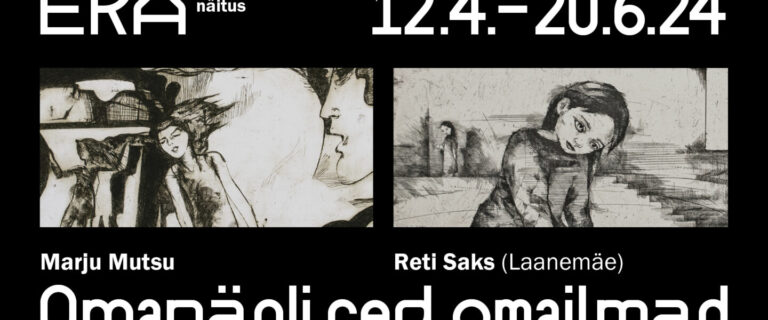
This exhibition presents the graduation projects of two notably distinct female print
artists: Marju Mutsu (1941–1980), who graduated in 1969, and Reti Saks, formerly
Laanemäe (1960), who obtained her diploma in print art in 1987. From the outset,
both artists displayed a unique and unmistakable style. They both engrave their
visions with a sharp needle onto the acid resistant layer of a metal plate using intaglio
printing, specifically etching. Their interpretations of the world are profound and
characterised by a strong sense of generalisation – albeit expressed in entirely
different ways.
Marju Mutsu’s vibrant series Youth comprises six prints, each titled thematically:
Wind, Truth, Tenderness, Song, School and Earth. On one hand, we observe the
spirit of the 1960s reflected here, capturing the fast-paced rhythms of contemporary
life, alongside determined-looking men with strong jawlines. On the other hand, we
encounter unprecedented forms in Estonian printmaking, witty suggestions,
fragmentation of the pictorial space, as well as emotional experiences, mental states,
and the beauty of nature’s fragments. The uniqueness of Mutsu’s print art lies not
only in its dynamic expression and Astrid Lindgren-like humour, but also in its
exploration of all the possibilities of intaglio printing and bold experimentation: at
times, the plate is not completely wiped clean of printing ink, the outlines of
recognisable figures blend into abstraction, and the surface of the printing plate itself
becomes a character.
The joyful print artist departed from us prematurely, at the young age of just 39.
Reti Saks’ series of seven images Games exudes a more subdued and static tone.
From the outset, the artist has been on a quest for answers to life’s profound
mysteries, delving into the enigma of life and death. The depth of exploration,
sometimes even penetrating the surface of the image itself, is evident in the sheet
titled Deep Print. Other prints, like Stairs, Ribbon and Walker, signify human choices,
whereas works such as Eye to Eye, Hand and Picture illustrate the enigmatic ways in
which the world can be perceived. The artist reflects the world through herself, with
her images literally bearing her own visage. In a metaphysical expanse of imagery, a
semi-frozen figure of a child-woman emerges, often in repetitive iterations,
reminiscent of the artist herself. This deeply introspective exploration of the world is
both painful and melancholic, yet it is also rich and multi-layered.
Reeli Kõiv
curator of the exhibition
Graphic design: Pärtel Eelmere
Chamotte gardenvase for a weekend house: 100 Years of design assignments
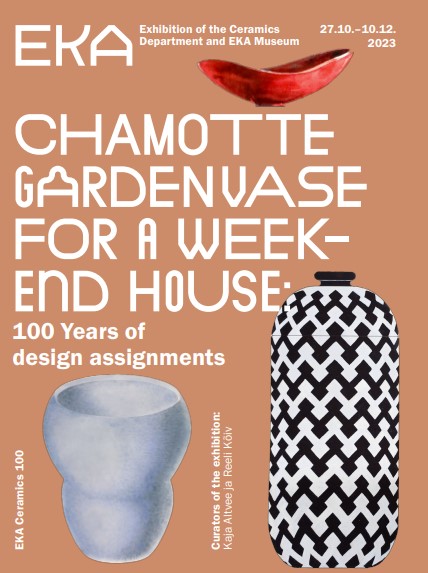
Exhibition of the Ceramics Department and Museum of the Estonian Academy of Arts.
The main material in ceramics, clay, has formed over the course of millions of years,
and the oldest clay artefacts date back thousands of years. In comparison, the one
hundred year history of the Ceramics Department at the Estonian Academy of Arts
(EKA) is merely the blink of an eye. Our professional ceramics training, which began
in 1923 at the State School of Arts and Crafts, EKA’s predecessor, is almost as old
as the Republic of Estonia. The discipline, which was narrowly classified as applied
art in the past, has undergone a significant transformation over this period of time
and has now assumed its place on a much broader scale of arts.
The commemorative ceramics exhibition has been compiled from student works
stored in the Methodological Fund of the Ceramics Department, now the EKA
Museum. Some works at the exhibition have also been borrowed from the artists.
Despite certain gaps in the collection, the exhibition still provides a comprehensive
overview of the history of ceramics throughout the century. We can see the
influences of the first head of department, Hungarian Geza Jako, as well as national
self-searching, inspirations from different art styles of the era and the blurring of
boundaries between applied and liberal arts. The ceramics collection is not deemed
final, as it is constantly being supplemented with older works as well as new student
projects, both at the initiative of the museum and the department.
The title of the exhibition, Chamotte garden vase for a weekend house, comes from
the name of a design assignment from the 1960s, of which only a draft is displayed in
the exhibition. Although the ceramics department has also designed large-scale
items over the years from fireplaces and fountains to panels, only a few of them were
realised and they are not on show in this exhibition. Instead, a selection of designs is
exhibited, many of which act as independent works of art. Several of them are also
paired with physical objects in showcases. The ceramic works are divided into five
major subcategories at the exhibition, offering one possible perspective: vessels,
figures, vases, sets and plays with form, which tell their own story and enter into a
dialogue with their neighbours. The booklet accompanying the exhibition will also
include a more in-depth introduction of the selected works by the artists or curators.
Meeting the Alphabet Book’s Rooster
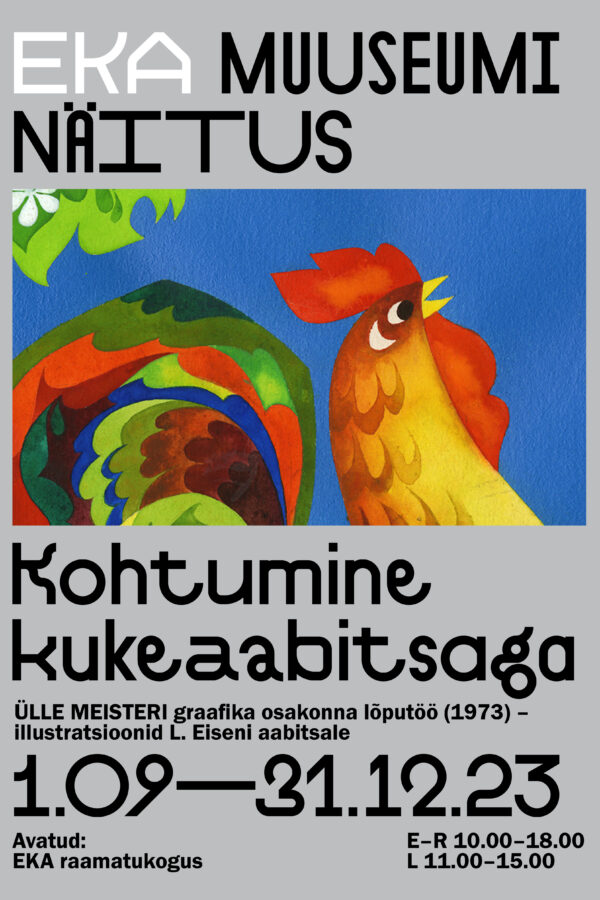
In the EKA Library, you can now see the exhibition “Meeting the Alphabet Book’s Rooster” marking the beginning of the academic year. Curated by the EKA Museum, this exhibition radiates with the brilliance of watercolour technique in Ülle Meister’s truly masterful diploma work, showcasing the illustrations from the year 1973 for the Estonian Alphabet book.
On August 27th, Ülle Meister (1948–2021) would have celebrated her 75th birthday, and this exhibition pays homage to the anniversary. The late artist favoured watercolour as her medium during her university years, and she remained loyal to it throughout her lifetime. Ülle Meister’s illustrated alphabet book (1974, L. Eisen) remained in use in schools until the 1980s and still evokes nostalgia and delightful recognition today. Meister’s work stands out not only for its exceptional technical finesse but also for its unique portrayal of the lifestyle of the era. The novel stylization of the 70s era fashion worn by the children and contemporary interiors adorned with trendy large-patterned textiles catch the eye. And of course, the school uniforms of the time and iconic toys of the late soviet period such as the tin bucket and shovel or beloved blue-striped Sipsik doll, all capture the essence of the period. The masterful watercolorist’s vivid brush strokes, seamlessly merging into one another, bring an immediate sense of joy to the viewer.
A Child Thing: Children’s designs by students at EKA
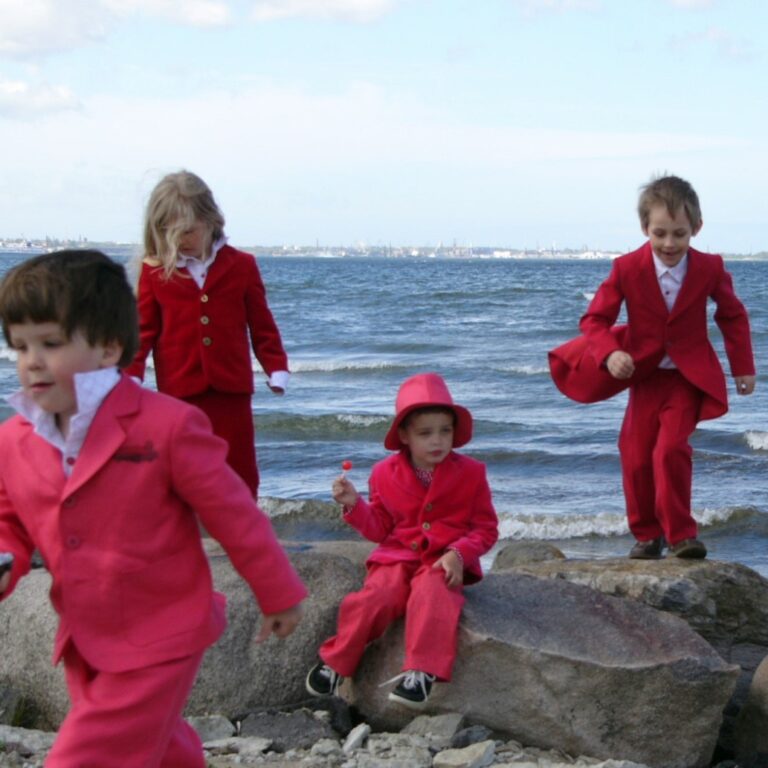
The exhibition A Child Thing: Children’s designs by students at EKA (2022) held at the EKA Gallery covered almost a century, starting from the well-known rooster illustration for the ABC book from the time of the State School of Arts and Crafts and ending with interactive objects from the last decade. The exhibition was largely based on the historical collection of the EAAM. Numerous established fashion, textile and leather artists, ceramicists, designers and interior architects in Estonia have worked with children’s designs during their student years. Besides the practical world of design, the exhibition also presents book illustrations, theatre costumes and animations from the realm of fairy tales that help stimulate the imagination of children. At the Estonian Academy of Arts, the topic of children has received more attention since the 1970s. From the aesthetic utility objects of the 20th century, we are increasingly moving towards solutions that engage children and develop their creativity.
Scattered permanent exhibition
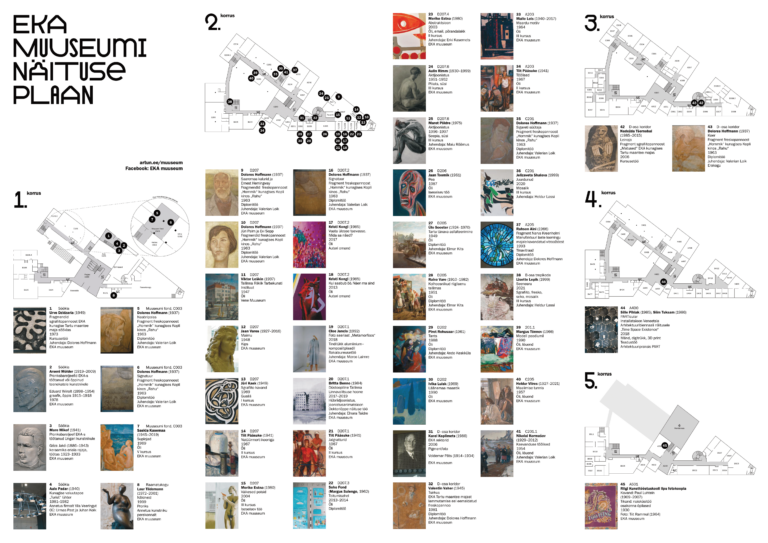
The scattered permanent exhibition of the EAAM is a site-specific phenomenon, where the geometry of the rooms, lighting and also the atmosphere have been considered in the selection and placement of the works, as well as the preferences of the people working in these spaces. The goal has been to improve the working and learning environment as well as to introduce the cultural heritage of the academy to the public. Oil paintings, sgraffiti, frescoes, sculptures and stained glass works completed at different times connect the history of the former Tartu Road building with the new building designed by KUU Architects into a single whole. The plan of the scattered permanent exhibition can be found here.
Invisible Monumental Painting
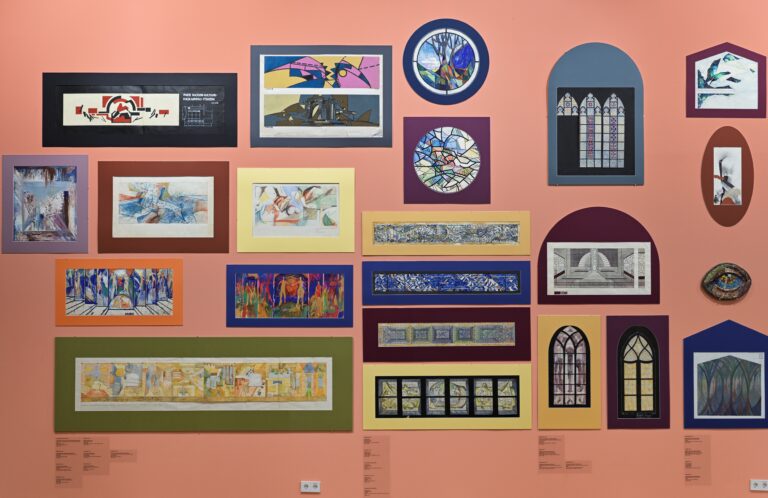
The 2020 exhibition Invisible Monumental Painting presented the EAAM’s exciting collection of monumental painting designs from 1962–1995, which includes conceptual designs for frescoes, sgraffiti, mosaics and stained glass. In order to highlight the technical singularity of monumental painting, 12 completed works were displayed at the exhibition. The catalogue accompanying the exhibition contains a historical overview of the teaching of monumental art at EKA and lists with images: the list of the exhibited items and also the list of monumental paintings completed in public spaces. Issues related to the field were reflected on in a discussion group of artists from different generations.
Photo: Stanislav Stepaško
ERR. EKA muuseumi kuraator: monumentaalkunstis on materjal kõige olulisem
Estonian Academy of Arts 105
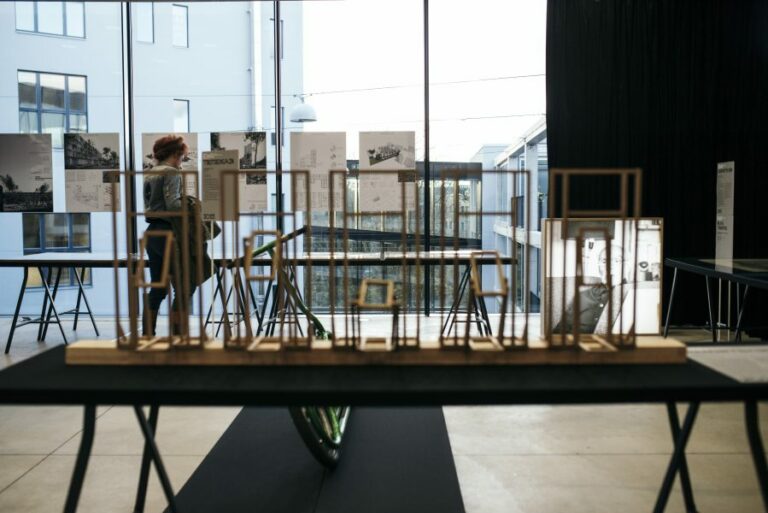
The exhibition From the Beginning to Today: 1+1 was an important part of the 105th anniversary programme of EKA. Each discipline taught at the Academy of Arts was represented by two works: one from the early days of the school and the other from the present time. The selected works demonstrated the connection between several creative generations at the academy and the changes that have taken place in art.
Photo: Patrik Tamm
Kuku raadio intervjuu. Reeli Kõiv – EKA 105 ja näitus Algusaegadest tänasesse
Eesti Päevaleht. EKA muuseumis on hoiul Eesti kunstiajaloo tundmatud aarded
Restless “Morning”
The first exhibition of the EAAM, Restless “Morning” was completed as a collaborative project with the Department of Cultural Heritage and Conservation in 2019. The central theme of the exhibition was Dolores Hoffmann’s graduation project in fresco technique from 1962/1963 and the department’s mission to rescue part of the fresco in the former Rahu Cinema in Kopli before the demolition of the building. At the exhibition, the destroyed parts of the 74 square metre monumental work were exhibited virtually, displaying the saved pieces that had reached the museum’s collection in real life as part of the installation.
Exhibition team: Hilkka Hiiop, Frank Lukk, Taavi Tiidor, Varje Õunapuu, Andres Uueni, Maris Veeremäe, Reeli Kõiv and Anneli Randla
Photo: Ainar Luik
A Hundred Years of Art Education in Tallinn
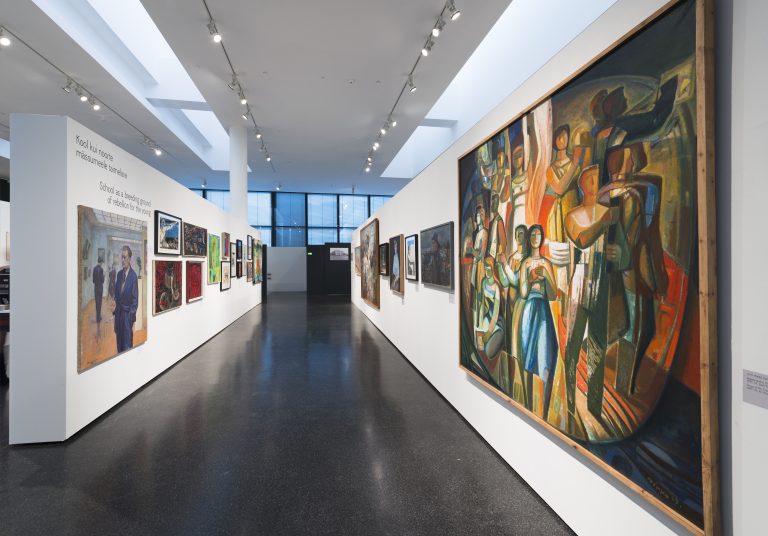
The largest and most prominent exhibition to date, which was largely based on EKA’s art collection, was A Hundred Years of Art Education in Tallinn (curator Mart Kalm) in Kumu art museum in 2014/2015, organised to celebrate the centennial of EKA.
